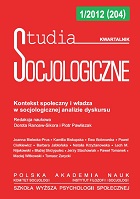Kategoria dyslokacji w analizie zmian zachodzących w polskim dyskursie publicznym po katastrofie w Smoleńsku
The Category of Dislocation in the Analysis of Changes in Polish Public Discourse after the Smolensk Catastrophe
Author(s): Maciej WitkowskiSubject(s): Social Sciences
Published by: Instytut Filozofii i Socjologii Polskiej Akademii Nauk
Keywords: discourse analysis; Smolensk catastrophe; hegemony; post-Marxism; political discourse
Summary/Abstract: In theoretical model of discursive hegemony by Chantal Mouffe and Ernesto Laclau political antagonism is the competition between different ways of representing the world in public discourse. In this model shared political projects allowing domination over larger fragments of discourse are understood as important factors for the new social order emergence. Social and political changes are interpreted with the reference to the category of “dislocation”. One can speak of dislocation when the events that are difficult to describe in the framework of the dominant system of meanings unfold. They disrupt the existing symbolic order and lead to the changes in the hierarchy of hegemonic projects. It is held that the crash of the airplane carrying the Polish President and nearly a hundred state officials to Smolensk, where Katyn victims’ commemoration ceremony was to take place in 2010, referred to as Smolensk catastrophe, have caused the experience of crisis and can be interpreted as the dislocation. In the article the new symbolic order emergence in the aftermath of the catastrophe is studied by discourse analytical tools. The research material has been taken from “Gazeta Wyborcza” and “Rzeczpospolita”, the leading Polish daily quality newspapers. The article is aimed at evaluating whether the Mouffe and Laclau theoretical model is useful in analyzing the mechanisms of the new discursive counter-hegemony emergence.
Journal: Studia Socjologiczne
- Issue Year: 204/2012
- Issue No: 1
- Page Range: 131-147
- Page Count: 17
- Language: Polish

